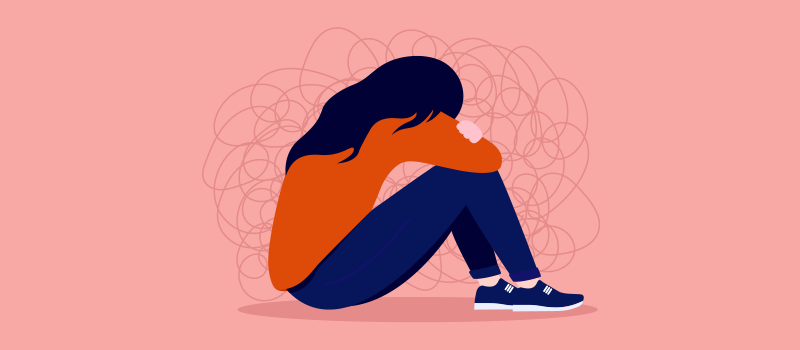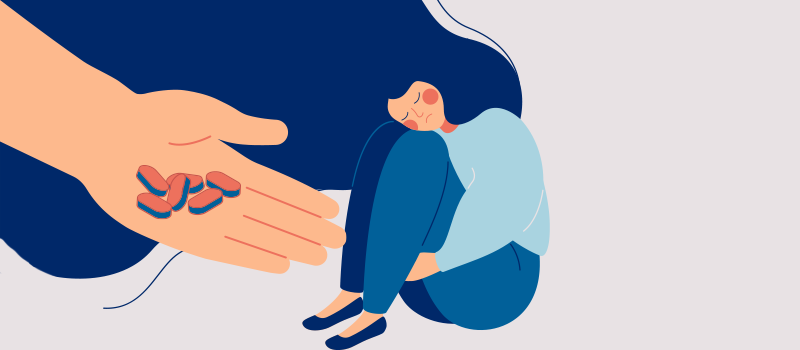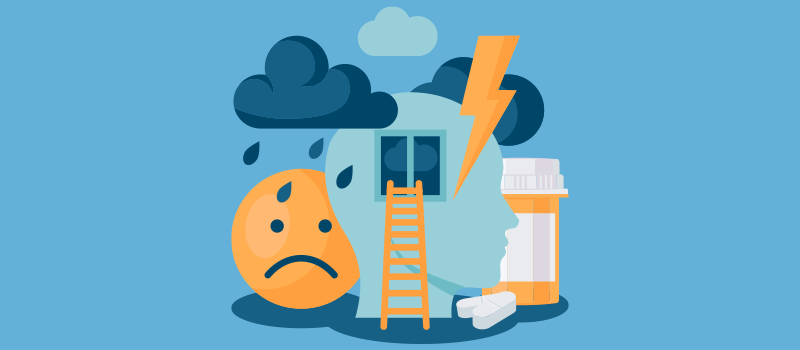What’s the Buzz
The Bee Healthy Blog
What are the Symptoms of PTSD?

Post-traumatic stress disorder (PTSD) is a mental health condition that usually develops after a person experiences or witnesses a traumatic event. People develop PTSD after a physical or sexual assault, a terror attack, a natural disaster, childhood abuse, physical abuse, or an accident experienced in the recent or distant past. These painful and traumatizing events may cause an individual to develop PTSD.
People who have experienced such events cope with their thoughts and feelings differently. Some people experience temporary sadness and despair. With time and proper mental health treatment, they are usually able to return to their daily activities. However, sometimes, people with PTSD experience long periods of depression and emotional detachment that significantly affects their ability to function in day-to-day life.
In this article, we'll explore what the symptoms of PTSD are and how it can be treated.
What are the symptoms of post-traumatic stress disorder (PTSD)?
Symptoms of PTSD can be divided into four main categories. These symptoms may start to appear immediately after the traumatic event has occurred. In other cases, the individual may develop PTSD symptoms months after the traumatic experience.
When placed in a situation where your safety is compromised, your nervous system kicks into flight-or-flight mode. As the event subsides, the nervous system returns to its normal state. It's perfectly natural to experience feelings of fear, shame, guilt, or anger after going through a traumatic event. Those are normal reactions to a dangerous or life-threatening situation.
For most people, these feelings may last for days or a few weeks, but they will gradually lift and subside as they heal from the traumatic event. However, when a person encounters too much traumatic stress, their nervous system does not tap out of fight-or-flight mode and return to its normal state. This may lead to them developing PTSD (post-traumatic stress disorder) and experiencing further trauma.
Let's take a closer look at the four main categories of post-traumatic stress disorder (PTSD) symptoms.
Symptoms of intrusion
The individual may start experiencing flashbacks, nightmares, repetitive thoughts of the traumatic events, or be reminded of traumatic memories by certain objects, words, physical sensations, or situations they encounter.
The different symptoms of intrusion typically include the following:
-
Having recurrent distressing memories of the traumatic event
-
Experiencing recurrent nightmares that are linked to the event
-
Having flashbacks where the person feels or acts like the traumatic event is recurring
-
Experiencing prolonged or intense distress when exposed to triggers or cues that remind them of the event
-
Having physical symptoms (e.g., stomach aches, rapid breathing, shakiness, pounding heartbeat, etc.) when exposed to cues that remind them of the event
To be diagnosed with PTSD, the individual should be experiencing one or more of the above symptoms.
Avoidance symptoms
After a person experiences a traumatic event, avoidance symptoms may start to present themselves. Symptoms of avoidance include the following:
-
Avoiding memories, negative thoughts, and feelings that are closely associated with the traumatic event
-
Avoiding external cues, such as people, places, conversations, objects, activities, and situations, that are linked closely to the traumatic events
For a PTSD diagnosis to be made, the individual should be experiencing one or both of the above avoidance symptoms after a traumatic event happened to them.
Cognitive and mood symptoms
Changes in mood and cognition may appear in people with PTSD. These cognitive changes and mood symptoms include the following:
-
Forgetting a significant part of the traumatic event
-
Having persistent negative thoughts and beliefs about themselves or those around them (e.g., "I cannot trust anyone" or "I should never go outside")
-
Having exaggerated feelings of blame toward themselves or other people
-
Experiencing persistent negative emotions, including irritability, angry outbursts, and feelings of horror, guilt, worry, or fear
-
Having little to no interest in activities they once enjoyed
-
Feelings of detachment and isolation from people around them
-
Being unable to experience or express positive emotions, such as happiness, satisfaction, or love
An individual diagnosed with post-traumatic stress disorder (PTSD) typically experiences two or more of the above symptoms.
Dissociative symptoms and forgetting significant parts of the traumatic event may also be a sign of depersonalization or derealization. Depersonalization is the recurrent or persistent experience of being detached from your own mind and body, as though you are an outside observer. Meanwhile, derealization is the feeling that the world around you isn't real.
Alterations in arousal and reactivity
Arousal symptoms are usually constant, disrupting the person's ability to sleep, eat, or carry out daily activities. These arousal symptoms may include the following:
-
Constant irritability, angry outbursts, and even physical or verbal aggression
-
Acting in a reckless or self-destructive manner
-
Constantly feeling on guard or on edge
-
Being easily startled
-
Having difficulty concentrating
-
Having trouble sleeping (difficulty falling or staying asleep)
A diagnosis of post-traumatic stress disorder (PTSD) may be made if the person experiences two or more of the above symptoms.
It's also important to note that people with PTSD often develop other mental health problems along with PTSD. These other mental health conditions may include severe depression, anxiety disorders, or substance abuse disorders.
Diagnosing posttraumatic stress disorder
Apart from meeting the minimum number of symptoms in each one of the four categories above, the following are other criteria a mental health professional would need to diagnose people with PTSD:
-
The PTSD symptoms are present for longer than a month.
-
The PTSD symptoms are disruptive enough to interfere with their career, social life, or other important functions in their daily life.
-
The symptoms cannot be attributed to another medical or mental health condition or substance abuse.
Your doctor will likely ask you questions about your specific symptoms and the traumatic experience to properly diagnose your condition. They may also perform physical examinations or lab work to ensure your symptoms aren't due to an underlying medical condition.
How to treat PTSD after a traumatic event
People with PTSD should seek medical advice from mental health professionals who have experience treating the condition. According to the American Psychiatric Association (APA), PTSD may be treated with medications, trauma-focused psychotherapy, or a combination of both.
The following are some treatment options for PTSD that your mental health specialist may recommend:
-
Medications: PTSD is commonly treated using antidepressants, which help regulate mood, appetite, focus, and sleep. They may also help to treat any co-occurring mental illness, like depression or anxiety.
-
Cognitive processing therapy (CPT): CPT is a form of talk therapy that teaches individuals the skills they need to identify and address unhelpful thinking patterns and modify their beliefs linked to the traumatic event.
-
Prolonged exposure therapy: This form of therapy helps the individual gradually approach the memories and feelings linked to traumatic events in a safe environment. This allows the person to learn helpful coping skills to face their feelings and fears related to the traumatic event.
-
Eye movement desensitization and reprocessing (EMDR): This involves recalling the traumatic event while making specific eye movements. EDMR may help to reduce the emotions and vividness of the memories linked to the traumatic event.
When to see a mental health professional
Having upsetting and confusing thoughts after experiencing or witnessing something traumatic is a normal reaction. After experiencing traumatic events like a sexual assault, physical abuse, an accident, or other traumatizing experiences, it is common to experience mental health problems like an anxiety disorder, depression, or other mood symptoms.
However, if you notice you've been experiencing PTSD symptoms for more than a month, it's best to seek medical advice from a mental health professional to help you start to learn how to manage symptoms, avoid a worsening mental health problem, and avoid further trauma. It's even more crucial to seek support and treatment if your symptoms interfere with your relationships, school, work, and social life.
You can also ask your doctor or hospital to refer you to a specialist and mental health services in your area. Healing from PTSD will take time. It's a gradual and ongoing process, but with the right support and treatment, you'll be in a better position to manage symptoms of PTSD and regain control over your life.
References
1. https://www.ncbi.nlm.nih.gov/books/NBK207191/box/part1_ch3.box16/
2. https://www.ncbi.nlm.nih.gov/books/NBK559129/
3. https://www.ncbi.nlm.nih.gov/pmc/articles/PMC1297500/
4. https://www.apa.org/ptsd-guideline/treatments
5. https://www.apa.org/ptsd-guideline/treatments/cognitive-processing-therapy












SOCIAL